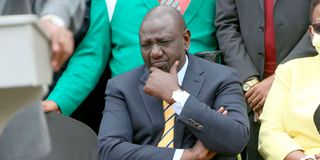Unmasking the real power behind Ruto’s ‘Hustler Nation’ juggernaut

Deputy President William Ruto during a meeting with politicians allied to United Democratic Alliance at his Karen residence on August 5, 2021.
What you need to know:
- Over the past six decades, the Kalenjin elite has emerged as the most strategic ethnic power.
- Jaramogi Oginga Odinga famously defined Moi as the giraffe that could see far and predict the future.
“It feels as though the country is at war,” lamented a human rights activist commenting on Uganda’s January 14, 2021 election. Since then, the ‘democracy as war’ trope continues to cast a long shadow over Kenya-Uganda diplomatic relations.
This week, state officials stopped Deputy President William Ruto from making “a private visit” to Entebbe, Uganda. This nipped what is touted in the corridors of power as the largest ever transfer of campaign ‘war chest’ in modern Kenya.
Democracy as “war and peace” may be a globalised phenomenon. But in Kenya, it is a mundanely local affair. A fierce three-way ethnic competition for the control of state power involving the Kikuyu (17.2 per cent), Kalenjin (12.9 per cent) and Luo (10.5 per cent) power elites is intensifying.
Over the past six decades, the Kalenjin elite has emerged as the most strategic ethnic power. Since 1957, they have successfully mobilised 11 other culturally related tribes – Kipsigis, Nandi, Keiyo, Marakwet, Sabaot, Pokots, Tugen, Terik, Sengwer, Lembus and Ogiek – into one political identity.
Their two kingpins, Daniel Moi (1957-2002) and Ruto (2002-2022), have been in power either as second-in-command or presidents for a total of 45 years out of 58 years of Kenya’s independence.
As Chinese military strategist Sun Tzu once advised, “Let your plans be dark and impenetrable as night, and when you move, fall like a thunderbolt.”
Ruto is the ‘soft’ front of a very hard and strategic architecture of Kalenjin power. In the early 1960s, the strategy was to be the bold voice of Kenya’s ‘minorities’, mainly herders, against ethnic majorities: Kikuyu, Luo and allied Kamba.
They crusaded for ethnic federalism or ‘Majimboism’ ‘to “protect minority rights”. Their party, the Kenya African Democratic Union (Kadu), however, lost power in the 1963 election.
Majimboism was dismantled, but the Kalenjin elite fanned up the “native-settler” or “indigenous-migrant’ dichotomy to assert exclusive claim to land and power in the former “White Highlands”.
Buy-one-get-three deal
This enabled Moi to replace Jaramogi Oginga Odinga as vice-president, succeed Jomo Kenyatta as President in 1978 and to run one of Africa’s most withering ethnic aristocracies.
When it became certain Moi would exit power after 1989, they devised a strategy where informal power came to rest on the Kalenjin Council of Elders, coupled with the ‘deep state’ and modern structures of church, business and professionals.
After 1989, the regime invented a new hybrid identity known as Kamatusa (Kalenjin, Maasai, Turkana and Samburu) to stymie the pro-democracy challenge, enabling Moi to stay in power for another decade.
Jaramogi Oginga Odinga famously defined Moi as the giraffe that could see far and predict the future. After the 1992 election, the Kalenjin courted the Luo. After the 1997 election, Moi drew Odinga’s son, Raila, into a political marriage with Kanu.
But a hastily cobbled Kalenjin-Kikuyu-Luhya triple alliance to succeed Moi involving Kalenjin eminence grises, Uhuru Kenyatta and Musalia Mudavadi was parodied as a ‘buy-one-get-three deal’ and defeated in the 2002 elections.
However, the rejection of the government-sponsored constitution by 58 per cent of voters at the 2005 referendum emboldened the Kalenjin elite to take on the Kikuyu elite.
Gabrielle Lynch’s article, ‘Courting the Kalenjin’ published in the African Affairs Journal (2008) creates the false impression that it is the Luo who courted the Kalenjin ahead of the 2007 elections.
In reality, it is the Kalenjin elite who courted the Luo, embracing the Raila Odinga card to “teach the Kikuyu a lesson”. Raila was Kalenjinised as “arap Mibey” in a new patron-client arrangement.
The ODM wave in the Rift Valley raised Raila’s ‘electability’ from 665,725 (10.9 per cent) votes in 1997 to nearly 4.4 million (44 per cent) in 2007.
Lynch is, however, right that the ODM wave defeated the “dynasticism” associated with Kanu under Moi and Uhuru Kenyatta, who backed Kibaki in the 2007 polls. Thus the dynasty versus hustler divide was born.
Acrimonious 2017 elections
But soon Prime Minister Odinga became assertive and failed to listen to his patrons. Then the International Criminal Court (ICC) struck. The Kalenjin dropped the Luo and courted the Kikuyu for a power-sharing arrangement after 2013.
However, after the acrimonious 2017 elections, the Kalenjin elite fiercely protested against Uhuru Kenyatta’s idea of a Kikuyu-Kalenjin-Luo triple détente as the pathway to “perpetual peace.”
In political platforms and courts, they fought the March 2018 “handshake” and the Building Bridges Initiative (BBI), which threatened to dim their chances of automatically ascending to power in 2022 on the Kikuyu-Kalenjin tyranny of numbers.
This war has given rise to a complex 2022 game-plan. Ruto has retained intact the idea of Kikuyu-Kalenjin détente that defeated Raila in 2013 and 2017. But he has shifted the axis of competition from ethnicity to class.
He has championed a ‘bottom up rhetoric’ , which exploits inequalities and the socio-economic impact of the Covid-19 pandemic, unemployment, poverty, historical grievances and social cleavages in Mt Kenya over land to hoodwink the poor.
Taking on the Kikuyu-Luo-Luhya and Kamba elite is not a reckless game in air-diving. The Kalenjin strategists know Raila is trapped. Without the usual anti-Kikuyu rhetoric, he risks losing his fanatical following.
Yet, besides his war chest, the anti-Raila card is Ruto’s most powerful tool in mobilising the Mount Kenya vote.
The logic is war, not peace. The method is conquest, not negotiation. And the likely result is Kenya’s relapse into the Moi-era autocracy.
Professor Peter Kagwanja is former Government Adviser and currently Chief Executive of Africa Policy institute (Kenya).





